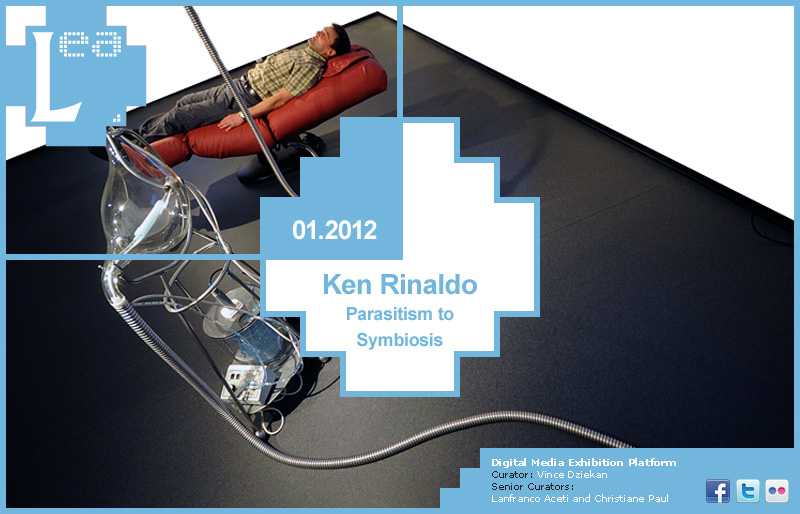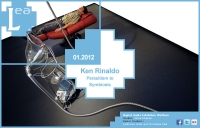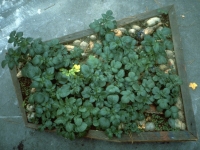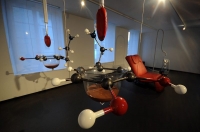- I Yam What I Yam, 1989, Ken Rinaldo.
- Ken Rinaldo, ‘The Enteric Consciousness’ (Installation view from the exhibition “Les robots rêvent-ils du printemps?”, Maison d’Ailleurs, Yverdon. September 2010).
LEA Digital Media Exhibition Platform
PARASITISM TO SYMBIOSIS BY KEN RINALDO
2012 opens up with a new exhibition for the Digital Media Exhibition Platform of the Leonardo Electronic Almanac curated together with Vince Dziekan. The LEA curatorial group for the Digital Media Exhibition Platform is composed of Vince Dziekan as curator and Christiane Paul and myself as senior curators.
We are excited to launch the second full year of LEA’s digital exhibition platform by presenting Parasitism to Symbiosis by Ken Rinaldo throughout the month of January 2012. Rinaldo’s practice is recognized for its integration of organic and electro-mechanical elements in installations that blur the boundaries between the organic and inorganic. His robotic and bio-artworks assert the emerging symbiogenesis between technological and natural living systems. For his LEA exhibition, the artist will provide insight into the research, conceptualization and modeling processes involved in the realization of his recent body of work, including Enteric Consciousness (2010), Paparazzi Bots (2010) and Face Music (2011).
Rinaldo is an associate professor in the Art & Technology program at The Ohio State University. His works have been commissioned and presented internationally at leading museums, galleries and festivals, including Siggraph, Transmediale and Ars Electronica, where he was the recipient of an Award of Distinction in 2004 and received first prize for VIDA in 2001. Commentaries on Rinaldo’s work have been included in numerous books and anthologies including: Art and Electronic Media by Edward Shanken, Digital Art by Christiane Paul, Inside Arte e Ciencia (edited by Leonel Maura), The Art of Art History (edited by Donald Preziosi), and Technological to Virtual Art by Frank Popper.
Artist Statement
My contemporary art installations blur the boundaries between living systems and constructed technological systems. I research, develop and create unique interactive interfaces for humans, robots and other species by studying natural living systems. I interrogate the social and environmental implications for advanced technological systems and use these principles to construct active participation in my interactive art installation. My artworks define transpecies communication and bioart and I imagine and invent natural and robotic ecosystems along with interacting social robots. My artificial-life art installations interact with biological systems, as a means of bringing forth and asserting a co-evolution between natural living systems and our now coevolving technological systems.
My greatest insight comes from observing and studying the delicate, intertwined beauty of our natural environment and interspecies communication flows. I observe how this relates to our rapidly evolving technoscape and our cultural evolution as a species. Many of my works are concerned with the impacts technology has on other species, which have no voice. As parasitism changes to symbiosis in natural living systems, so this becomes model for how we can incorporate and think about technological systems integrating in natural living systems. As trillions of transpecies relationships already exist in our “individual” bodies, so we can imagine a time when manufactured technology has more fully penetrated and found acceptance in our natural living systems. Mitochondria a “foreign” organelle, already exists in our human cells and allow us to survive and lactobacillus acidophilus bacteria also exists inside our natural stomachs, creating bacterial colonies, which allow us to digest and process food.
In the Enteric Consciousness (2010), I have created an activated environment, in which living bacteria in an artificial glass stomach allows the participant to explore robotic touch, corporeal experience and massage in a large robotic tongue chair, only if the bacteria is living and healthy. This contemporary art installation asserts that we are not individuals; so much as we are symbiotic clouds of bacterial and human cells. Also part of this installation are two large artificial tongues, which robotically dip into and out of liquid chocolate pools, in glass bell jars suspended by massive dopamine molecules and suggest pleasure, touch and sex as central to symbiotic coevolution. Dopamine a neurotransmitter in both our brains and bellies is believed to mediate the subjective experience of pleasure, in humans and invertebrates.
The five Paparazzi Bots (2010) explore an emerging class of social robots that seek to elevate us to fame, by first manipulating us. They seek one thing, which is to capture photos of people (only if they smile) and to make these images available to the press and the world wide web as a statement of culture’s obsession with the “celebrity image” and especially our own images. The flash autonomously goes off, capturing people’s photos and elevating them to “celebrity” in a kind of momentary anointing by the robotic camera. The recent emergence of social networks and robotic pets and their ability to connect people through software is a prime example of the co-evolution of humans and their intelligent machines. The fact that these intelligent machines now exploit our social needs for connectivity is so easily exploited in this new critical juncture in our emerging machine human relations, where our intercommunication, is increasingly mediated by screen time and software prompts.
In Face Music (2011), hybrid, human / machines compose their own songs and music (primordial speech) with input from participant facial images. These six robots are covered with natural human hair and move as large flesh toned jointed appendages, toward human body heat as they capture snapshots. These snapshots are digitally processed, pixelated and turned into a constantly evolving generative soundscape. Here unique facial features are turned into guttural sound, melody and rhythm with six individual interacting robots, creating a symphony of evolving sound and real time projected image.
I am enthralled and encouraged by humankind’s struggle to evolve technological systems modeled on our current conceptions of “the natural” that move toward intelligence and autonomy. I am captivated by and enamored with technology as it increasingly emulates and mimics living systems. As much machine research is currently focused on creating machines for violent and offensive means, it is imperative that machine interactions evolve from parasitism to symbiosis, so we may peacefully coevolve. Peaceful symbiogenesis in an evolving biotope and technotope are my goals.
For more information about Ken Rinaldo:
https://www.kenrinaldo.com/
https://facemusic.us
https://www.paparazzibot.com/
https://farmfountain.com/
https://vimeo.com/kenrinaldo
https://www.flickr.com/photos/paparazzibot/
LEA International Curatoriate
Lanfranco Aceti & Christiane Paul (Senior Curators), Vince Dziekan (Digital Media Curator)
Follow LEA on:
Facebook
https://www.facebook.com/home.php?#!/pages/Leonardo-Electronic-Almanac/209156896252
Flickr
https://www.flickr.com/photos/lea_gallery/
Twitter
https://twitter.com/#!/LEA_twitts




